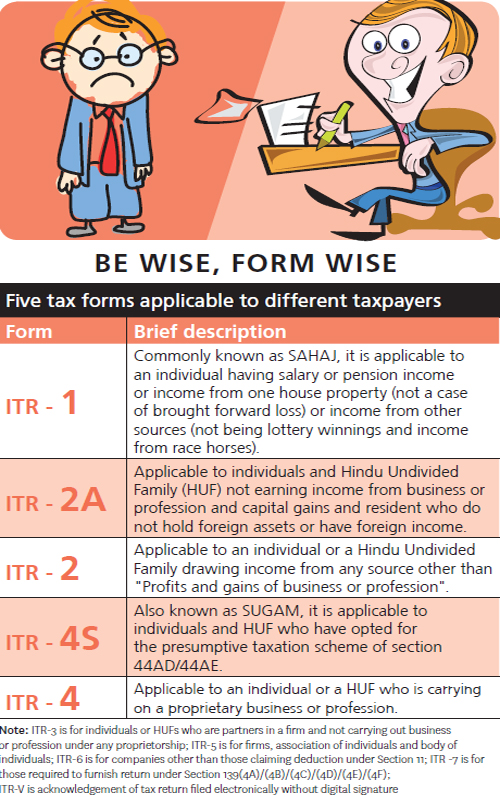Less taxing, returns filing
Don't Let the changes in tax forms get in your way for a smooth and hassle free tax filing.

The annual tax return filing season is in full swing with a couple of weeks before the July 31 deadline strikes. The tedious reputation of tax return filing continues this year with the series of changes introduced by the income tax department in the tax return forms. But that should not impact your plans to file returns considering the plethora of help available, which makes tax filing not only easy but also a rather smooth one and definitely not as unpleasant an experience as one assumes it to be. Remember, even if you have paid the taxes that you owe on the income you earned in Financial Year 2015-16, you still need to file your returns.
Even before you start, you need to be equipped with a few documents, primarily the Form 16. Salaried employees ideally receive Form 16 by June, if not earlier, which details the record of tax deducted and deposited so far on your behalf by the employer. You should also look up the tax credit statement (Form 26AS), which lists all the taxes deducted that are actually deposited with the Income Tax Department, including those from other sources like banks. Keep details of PAN, Aadhaar card, bank statements, including IFSC code and account numbers, interest statement from bank ready. In case you have let out a property, keep the rental deed and details of investments made to claim tax deductions.

These days, there are several portals that facilitate tax return filing and cater to the needs of all types of taxpayers. These portals offer several facilities which include faceto-face interaction if your tax filing necessiates the same. Alternatively, the online helpchats on these sites are equipped to handle most queries. Certain basic features are free, but the moment you need an expert view, the charges kick-in. Rates to help you file returns start from Rs.250 onwards and depend on the kind of service you opt for. You also have the option to file your returns by yourself by going to the income tax website.
Mistakes to avoid
Yes, the paperwork could be confusing and laborious, which often results in errors committed by taxpayers at the time of filing. While electronic filing of returns through the income tax website has made the process simpler, many tax-payers tend to fall into certain common traps that can cause monetary loss or even render the returns invalid. Here are some mistakes committed frequently by tax return filers that you can learn from and steer clear of.
Incorrect form: For assessment year 2016-17, the I-T department has introduced several key changes in ITR forms. Ensure that you choose the one that is applicable to you. “Out of the nine forms, six are for individuals and are applicable depending on their situation. Keep in mind that if you choose the wrong form, it will be treated as a failure to file returns,” says chartered accountant Amit Maheshwari, partner, Ashok Maheshwary and Associates.
New disclosures: The new ITR forms require all tax payers who earn an annual income of over Rs.50 lakh to disclose the cost of their assets, movable as well as immovable. “Failure to correctly report assets and liabilities in case your total income exceeds Rs.50 lakh could result in mistakes,” says Amarpal Chadha, tax partner, people advisory services, EY.
Non-reporting: Apart from cumbersome paperwork at your organisations while switching jobs, you have to deal with additional tax-related documentation as well. When you move on to another organisation during the financial year, you would have to submit investment proofs twice. This duplication can fetch you double tax benefit you are entitled to as both employers will consider the same deductions. “The onus is on you to ensure that no double benefit is availed of. Otherwise a large liability could arise in the future,” says Maheshwari.
Income declaration: Many salaried tax-payers file their returns solely on the basis of the Form 16 provided by employers. Consequently, they tend to leave out income earned through other sources, resulting in faulty returns that can haunt them later in the form I-T department notice. Not including interest earned from fixed deposits and income from investment made in the name of spouse or children are common mistakes. Remember, interest of up to Rs.10,000 received on savings bank account, and not term deposits, is eligible for deduction.
Missing out details: Regular deductions are easy to include, but capital gains is a complex affair. “Under short-term capital gains (STCG) many users get confused between STCG under section 111A (made on sale of equity shares and mutual fund units) and STCGothers,” points out Sankla. Similarly, you must not enter long-term capital gains exempt from tax in the capital gains section.
Non-filing: Since employers deduct taxes at the time of paying their employees’ salaries, some individuals are under the impression that they need not file returns
Verifying ITR-V: Filing returns can be a time consuming process, which leaves most tax-payers exhausted, resulting in many forgetting the last step—taking a print-out of the ITR-V or verification form and sending it to the I-T department’s central processing unit in Bengaluru. Remember, returns filed online are not considered valid unless you complete this final step. Alternatively, you can simply opt for electronic verification of returns using your Aadhaar.
Now that you are geared with all the necessary details on what you need to file returns, the actual process should not take too much of your time or worry you more. Happy tax return filing!









